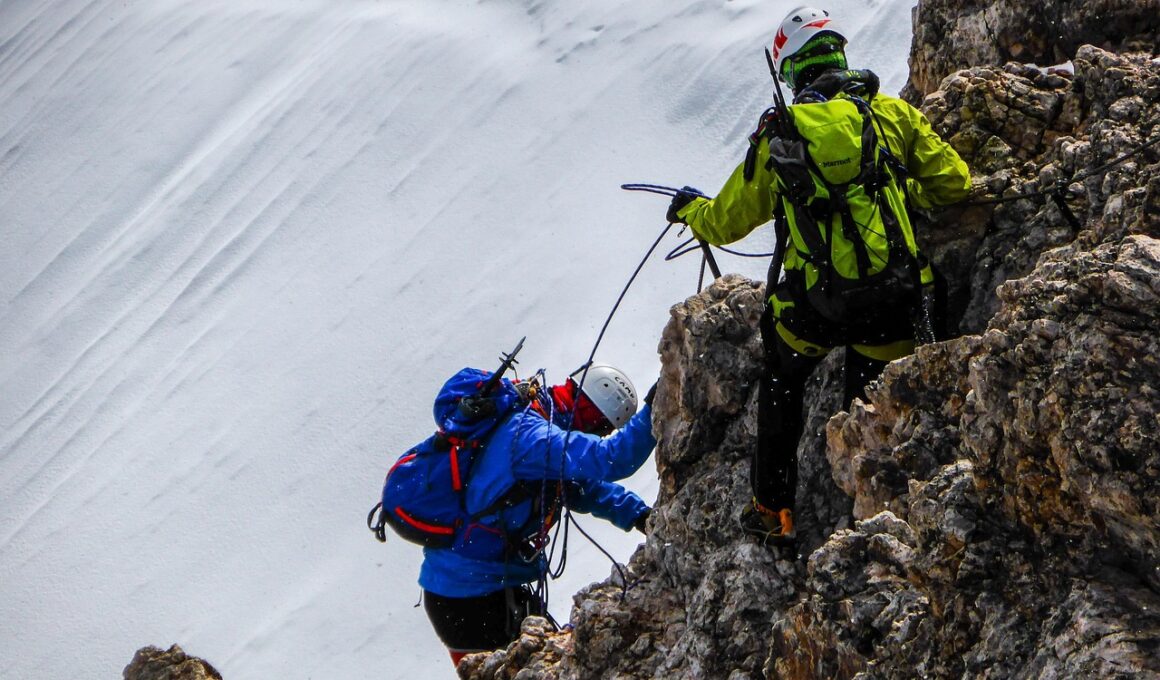How to Improve Your Balance for Steep Snow Climbs
Improving your balance is essential for steep snow climbs, as it directly impacts your climbing efficiency and safety. Many climbers underestimate the importance of balance in their approach. Unstable footing can lead to slips, falls, and a slower ascent. To enhance balance, consider incorporating balance-focused exercises into your training regimen. Exercises like single-leg stands, yoga, and dynamic balance drills can support your climbing. It’s also crucial to engage your core muscles, as strong core stability greatly aids balance. If you feel wobbly on your feet, practice standing on uneven surfaces; this will simulate the conditions you encounter while climbing. Adding a balance board into your routine can further develop your skills as well. In addition to physical training, enhance your mental focus. Concentration and awareness of your body position contribute significantly to better balance. Don’t forget to visualize your climb before starting; it can prepare your mind for the task. Regular practice in real snow conditions will help; small climbs can gradually increase your confidence. Lastly, seek feedback from experienced climbers; they may offer valuable tips to refine your technique.
Gear is crucial when striving for balance in steep snow climbs. Lightweight and supportive footwear is ideal. Choose boots that provide excellent grip and allow for flexible movement. Consider insulated boots if you plan to climb in colder conditions as they enhance warmth and comfort. Additionally, proper crampons are necessary; they should fit securely on your boots. The right crampons provide needed traction on icy surfaces, ensuring that you stay stable during your climb. Furthermore, a well-fitted harness contributes to overall safety and balance, enabling you to use your upper body for support as you navigate steep sections. Pay attention to your layering system as well. Being too warm can lead to reduced focus. Adequate but light clothing will prevent overheating and ensure comfort over time. Don’t forget your gloves; they’re vital for protection and grip. Invest in high-quality gloves that allow for dexterity while also providing warmth. You may also want to consider ski poles that can help maintain your balance in slushy or icy conditions. Lastly, ensure your climbing rope is in good condition for safety.
Practice Foot Placement Techniques
Strong foot placement techniques can dramatically enhance your balance and confidence on steep snow climbs. Always assess the terrain before placing your foot. Firm snow requires less adjustment than loose, powdery snow. In soft snow, aim for a minimal footprint; this reduces the chance of post-holing, which can destabilize your position. Maintain a low center of gravity; this can be achieved by bending your knees slightly while climbing. As you progress, focus on placing your weight directly over your support foot. This will ensure that your movements are both smooth and controlled. Practicing edging techniques with your crampons will also help firm up your balance. As you climb, try to engage your toes against the snow; this technique provides additional stability in uncertain conditions. In addition, consider alternating your leads in climbing. Switching between left and right regularly helps strengthen both sides of your body. Working on core rotations can also help develop better control and flexibility. Finally, remember not to rush; mindful foot placement turns into better balance overall, helping improve each climb you undertake.
Your mental approach is one of the most important elements in climbing balance effectively. Fear and anxiety can often impact your ability to focus, which can lead to poor balance and placement during climbs. Employ visualization techniques to create a positive mindset. Before your ascent, visualize each step carefully, imagining how you will move and balance. This mental preparation can improve your concentration and boost your confidence significantly. Allowing yourself to relax in stressful situations is vital too. Practice mindfulness techniques like deep breathing exercises before climbing; they will calm your nerves and sharpen your focus. Remember, creating a positive self-dialogue boosts your morale and ability to tackle climbs effectively. You should also consider practicing on easier routes before challenging ascents. This gradual exposure to higher difficulty levels will build your confidence naturally. Furthermore, seeking mentorship from seasoned climbers can offer invaluable insights to overcome emotional hurdles while climbing. The diverse experiences of others can open your eyes to new skills and tactics to conquer steep climbs. Lastly, keep a climbing journal to track your progress, reflect on challenges, and celebrate successes that build resilience.
Nutrition and Hydration for Climbers
Nutrition plays an essential role in your overall balance and climbing performance. A balanced diet ensures that you have the energy and coordination needed for challenging climbs. Focus on consuming a combination of carbohydrates, proteins, and healthy fats to fuel your body adequately. Complex carbohydrates from whole grains, fruits, and vegetables offer sustained energy levels. Lean proteins—like chicken, fish, legumes, and nuts—aid muscle recovery and strength. In contrast, healthy fats from sources such as avocados or olive oil also contribute to endurance. Consider incorporating micronutrients through a variety of colorful food sources. Vitamins and minerals, especially those that support muscle function like calcium and potassium, are crucial for balance and preventing cramps. Remember that hydration is equally crucial; dehydration can lead to diminished performance and balance. Aim to drink at least two liters of water daily before and during climbing. Electrolyte drinks should also be considered during intense physical activity under cold conditions. This ensures your body can maintain optimal function. Finally, practice eating small snacks during climbs to sustain energy levels throughout the ascent and enhance focus.
Engaging in specific balance exercises can vastly improve your performance during steep snow climbs. Start with simple exercises such as standing on one leg for extended periods. Gradually increase this difficulty by doing arm movements or standing on unstable surfaces. Yoga is particularly effective as it fosters overall body awareness and balance. Practices like tree pose and warrior pose help with stability while enhancing muscle control. Additionally, balance training tools such as Bosu balls or balance boards offer unique challenges that replicate climbing conditions. Incorporating these tools into your routine will keep your workouts engaging while improving your balance. You can also practice dynamic movements like hopping or jumping between two points. Exercises that involve lateral movement also help cultivate agility and balance, essential traits for climbing. Resistance training can build muscle strength that supports overall stability during climbs. Including exercises focused on your core, legs, and upper body will offer a well-rounded approach. Most importantly, remember to pair strength training with flexibility-focused exercises, such as stretching, to avoid injury. Creating a consistent training schedule around these activities ensures steady progress toward your climbing balance goals.
Conclusion and Tips for Improvement
In conclusion, improving your balance for steep snow climbs requires dedication, practice, and focus on various aspects of training. Incorporating proper gear is essential for maintaining stability and comfort during climbs. Engage in exercises that develop your core strength, flexibility, and dynamic movements while also taking care of your nutrition and hydration needs. Moreover, consider mental preparation techniques to enhance your focus and confidence. Regular practice on real snow will allow you to experience different conditions and adapt effectively, helping you to build resilience and skill over time. Don’t rush through your training; allow adequate rest between workouts to ensure optimal performance. Mentorship from experienced climbers can provide valuable insights while learning new techniques unique to your style. Finally, monitor your progress through various methods, such as journaling or video analysis. Remember that every climber encounters challenges, and persistence is key. By incorporating these strategies, you can significantly enhance your balance and comfort for steep snow climbs, leading to more successful and enjoyable climbing experiences in the wild.
Additional training techniques and insights into balance practice are available online. Websites that offer winter sports resources can be helpful, providing tutorials and community support to help sharpen your balance skills in various environments. Embrace the opportunity to learn from forums and videos featuring expert climbers who share their experiences and methods, fostering a deeper understanding of climbing fundamentals. Learning from seasoned athletes can inspire and motivate you to pursue your climbing goals. Don’t hesitate to explore options like guided training sessions, workshops, and climbing gyms that focus specifically on balance techniques, as they can offer structured environments for practice. Engaging in these communities often leads to valuable networking opportunities with fellow climbers. Ultimately, remember that balance is an ongoing journey, and there’s always room for improvement. By implementing these tips and dedicating yourself to consistent training, you can enhance your skills, ensuring you take on any snow climb with confidence and poise.


